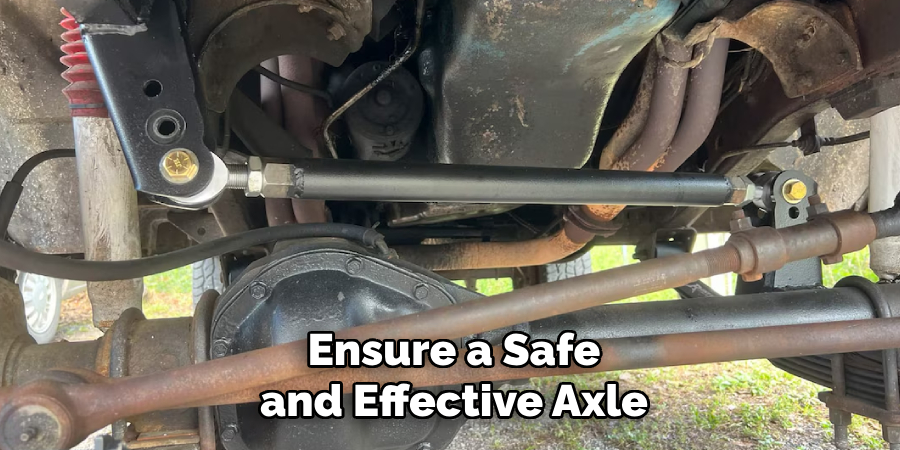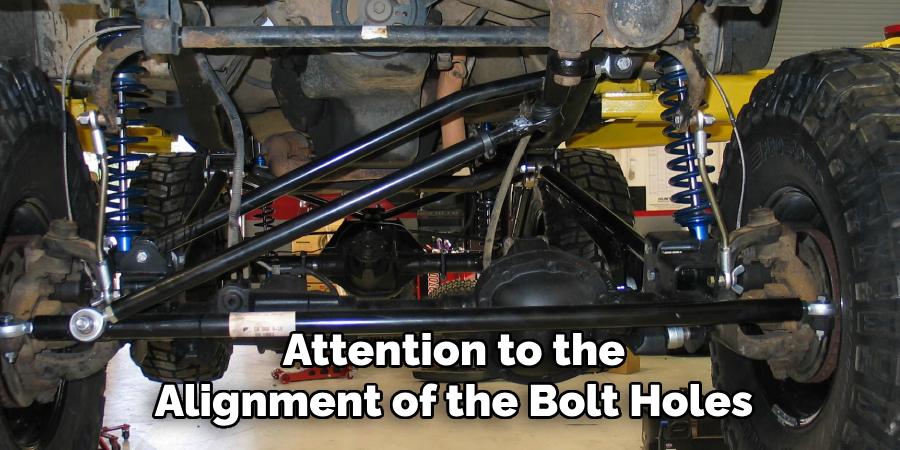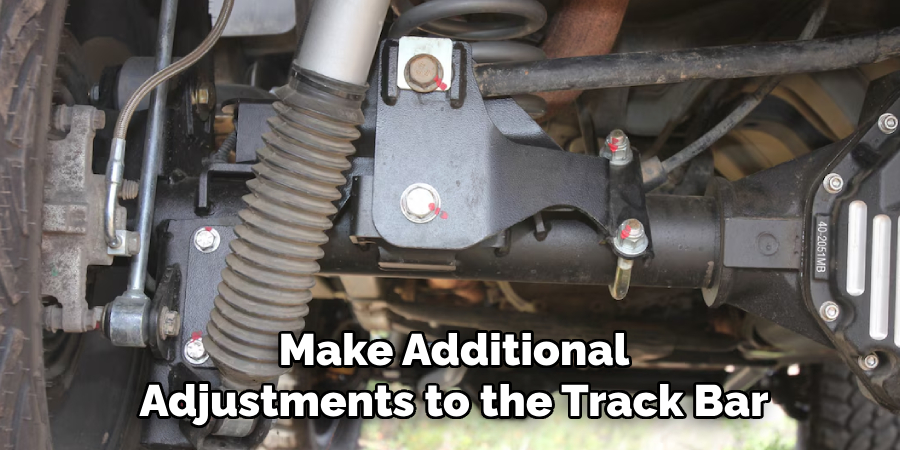In vehicle suspension systems, proper alignment and axle centering are crucial in ensuring optimal handling, tire wear, and overall driving experience. One component that plays a significant role in achieving axle centering is the track bar. This essential part helps maintain the axle’s position and prevents lateral movement, ensuring stability and control.
Axle centering becomes even more critical when modifying suspension systems or installing lift kits. This is where adjustable track bars come into play. These specialized track bars allow fine-tuning of the axle’s position, ensuring it remains centered under various driving conditions.

In this section, we will explore how to center axle with adjustable track bar, the role of adjustable track bars in suspension modifications, and provide practical insights on how to center the axle using an adjustable track bar. By understanding and implementing these techniques, you can achieve optimal vehicle alignment, improve tire longevity, and enhance overall handling.
Tools and Materials Needed
To properly center the axle using an adjustable track bar, you will need the following tools and materials:
Tools
- Socket set and wrenches for loosening and tightening bolts.
- Measuring tape or ruler for axle alignment.
- Floor jack and jack stands for safely lifting the vehicle.
Materials
- Adjustable track bar matching the vehicle’s make and model.
- Lubricant for bolts and joints, if necessary.
These tools and materials will ensure a smooth and efficient process when centering the axle using an adjustable track bar. Remember to follow proper safety precautions when working under and around the vehicle, and consult the vehicle’s manual for any specific instructions or guidelines related to installing the adjustable track bar.
Preparing the Vehicle for Adjustment
It’s important to prepare the vehicle properly before proceeding with the axle centering process using an adjustable track bar. Follow these steps to ensure a smooth and safe adjustment:
- Safety Precautions: Park the vehicle on a flat surface and engage the parking brake to prevent unwanted movement. If lifting the vehicle is necessary, use jack stands to support it securely.
- Inspecting the Current Track Bar: Before installing the adjustable track bar, inspect the existing track bar for any signs of damage or excessive wear. Ensure that your adjustable track bar is properly sized and compatible with your vehicle’s make and model.

By taking these preparatory measures, you can ensure a safe and effective axle centering process, which will improve alignment, tire longevity, and overall handling of your vehicle. Always prioritize safety and follow the manufacturer’s instructions throughout the adjustment process.
Measuring Axle Alignment
Accurate measurement of axle alignment is crucial before proceeding with the adjustment process. Follow these steps to effectively measure axle alignment:
Identifying Off-Center Axle Symptoms:
- Look out for signs of an off-center axle, such as uneven tire alignment or the appearance of one side of the axle sticking out. Other indicators include a steering wheel pulling to one side or unusual handling characteristics.
Taking Measurements:
- Measure the distance between the tire edge and the fender on both sides of the vehicle and record the difference between the two measurements. This discrepancy will help determine how much adjustment is needed to center the axle properly.
By carefully measuring the axle alignment and recognizing the symptoms of an off-center axle, you can effectively determine the necessary adjustments to achieve optimal alignment. This process ensures improved tire wear, handling, and driving performance. Remember to consult your vehicle’s manufacturer guidelines for specific instructions on axle adjustment procedures.
How to Center Axle with Adjustable Track Bar: Adjusting the Track Bar
Adjusting the track bar is crucial to effectively center the axle and achieve optimal alignment. Here’s a detailed guide on how to adjust the track bar:
Removing the Existing Track Bar
Begin by removing the current track bar from the axle and frame mounts. Carefully unbolt the track bar, ensuring you have the necessary tools for the job. Applying lubricant can help ease the removal process if the bolts are stuck or corroded.
Adjusting the New Track Bar
Once the existing track bar is removed, it’s time to adjust the new track bar. Referencing the earlier measurements, lengthen or shorten the adjustable track bar accordingly. The goal is finding the right length to help center the axle properly. Start by setting the bar to an estimated correct length for initial testing.
Installing the Adjustable Track Bar
With the new track bar properly adjusted, it’s time to install it. Attach the track bar to the frame and axle mounts, ensuring a secure fit. Tighten the bolts securely to ensure the track bar stays in place throughout the vehicle’s operation. Pay close attention to the alignment of the bolt holes, ensuring they align properly for a secure and stable connection.

By following these steps and adjusting the track bar accordingly, you can effectively center the axle and achieve optimal alignment. It’s important to consult your vehicle’s manufacturer guidelines for specific instructions on axle adjustment procedures to ensure accurate and safe adjustments. Proper axle alignment improves tire wear and enhances vehicle handling and overall driving performance.
Fine-Tuning Axle Alignment
After installing and adjusting the track bar, it’s essential to fine-tune the axle alignment to achieve optimal results. Follow these steps to ensure the axle is properly centered:
Re-Checking Measurements
Lower the vehicle to its normal ride height and carefully re-measure the axle alignment. Use the same reference points as before, such as the distance between the tires and the frame, to assess the centering of the axle. If the measurements indicate that the axle is still off-center, further adjustments to the track bar may be necessary.
Adjusting the Track Bar Incrementally
If the axle is still not properly centered, make incremental adjustments to the track bar. Loosen the track bar bolts slightly and use a wrench to turn the adjustment mechanism, either lengthening or shortening the bar as needed. After each adjustment, recheck the axle alignment to ensure it is centered. Repeat this process until the axle is properly aligned.
Testing Alignment Through Movement
To confirm the accuracy of the alignment, turn the steering wheel lock-to-lock several times. This movement helps settle the suspension and allows you to observe if the axle remains centered throughout the full range of steering. If any deviations are detected, make additional adjustments to the track bar until the axle maintains proper alignment during steering movement.

By meticulously fine-tuning the axle alignment through these steps, you can ensure that your vehicle’s suspension operates optimally, improving tire wear, enhanced vehicle handling, and an overall better driving experience. Remember to consult your vehicle’s manufacturer guidelines for specific instructions on axle adjustment procedures to ensure accurate and safe adjustments.
Testing and Verifying Results
After aligning the axle using the above adjustment process, it’s essential to test and verify the results to ensure proper alignment and functionality of your vehicle’s suspension system. Here are two critical steps to follow:
Road Testing the Vehicle
To assess the effectiveness of the axle alignment, take the vehicle for a road test at low speeds. Pay close attention to the vehicle’s handling and steering responsiveness. Look for smooth steering with no resistance or pulling to one side. A properly aligned axle will improve handling and stability, allowing for a smoother and more controlled driving experience.
Inspecting for Stability
During the road test, verifying that the axle stays consistently centered under various driving conditions is crucial. Observe the vehicle’s behavior when making turns, going over bumps or uneven surfaces, and during acceleration and braking. Additionally, inspect the track bar mounts to ensure they are secure and free from excessive play or movement. Any abnormalities or lack of stability may indicate the need for further adjustments or potential issues with the suspension components.
By thoroughly road testing and inspecting the vehicle’s stability, you can validate the effectiveness of the axle alignment and ensure that your suspension system is operating optimally. Regular checks and maintenance of the axle alignment will improve tire wear, enhanced vehicle stability, and a safer driving experience. Remember to refer to your vehicle’s manufacturer guidelines for any specific instructions or recommendations regarding axle adjustment procedures to ensure accurate and safe adjustments.
Maintenance Tips for Adjustable Track Bars
To keep your adjustable track bars in optimal condition and ensure their continued effectiveness, follow these maintenance tips:
Periodic Inspections:
Regularly inspect the track bar and mounts for signs of wear, looseness, or damage. Look for worn bushings, bent components, or excessive play or movement. Retorque bolts periodically to ensure a secure attachment and prevent any loosening over time.
Lubrication and Cleaning:
Keep the track bar’s joints well lubricated to prevent corrosion and ensure smooth operation. Use a suitable lubricant recommended by the manufacturer. Additionally, clean the track bar area regularly to remove dirt, debris, or road grime that can accumulate and potentially lead to issues.
By following these maintenance practices, you can prolong the lifespan of your adjustable track bars, maintain their optimum performance, and contribute to your vehicle’s overall stability and safety.

Note: Always refer to your vehicle’s manufacturer guidelines for any specific instructions or recommendations regarding maintenance procedures for adjustable track bars.
Conclusion
In conclusion, properly centering the axle with an adjustable track bar is essential for maintaining optimal vehicle alignment and handling. You can ensure a balanced and stable axle position by following the steps outlined in this guide, including measuring ride height, adjusting the track bar length, and verifying alignment. However, it’s crucial to remember that the alignment process may seem complex, especially for those unfamiliar with vehicle mechanics. In such cases, consulting a professional for assistance is highly recommended.
Additionally, regular maintenance practices such as periodic inspections, lubrication, and cleaning are vital for prolonging the lifespan and performance of adjustable track bars. Keep your vehicle in top shape and enjoy improved stability and safety on the road. Thanks for reading our post about how to center axle with adjustable track bar.
Edmund Sumlin is a skilled author for Metal Fixes, bringing 6 years of expertise in crafting a wide range of metal fixtures. With a strong background in metalwork, Edmund’s knowledge spans various types of fixtures, from decorative pieces to functional hardware, blending precision with creativity. His passion for metalworking and design has made him a trusted resource in the industry.
Professional Focus:
- Expert in Metal Fixtures : Edmund aesthetic specializes in creating durable and innovative metal fixtures, offering both appeal and functionality. His work reflects a deep understanding of metalworking techniques and materials.
- Sustainability Advocate : He is dedicated to using sustainable practices, ensuring that every fixture is crafted with eco-friendly methods while maintaining high-quality standards.
In his writing for Metal Fixes, Edmund provides valuable insights into the latest trends, techniques, and practical advice for those passionate about metal fixtures, whether they are professionals or DIY enthusiasts. His focus on combining artistry with engineering helps others discover the true potential of metal in design.


